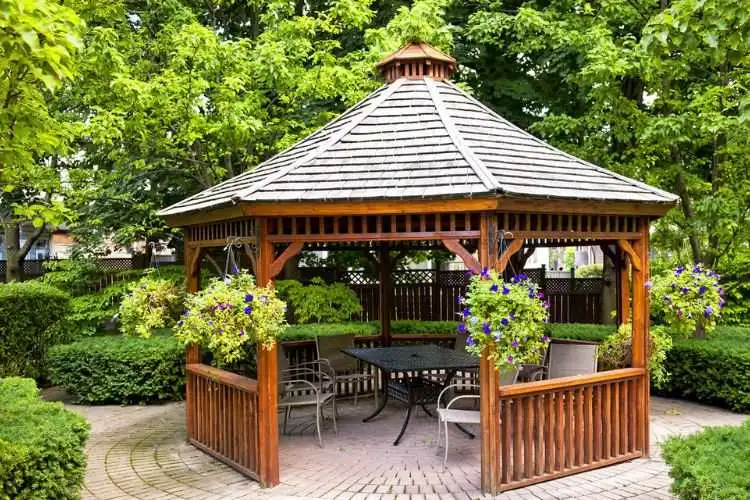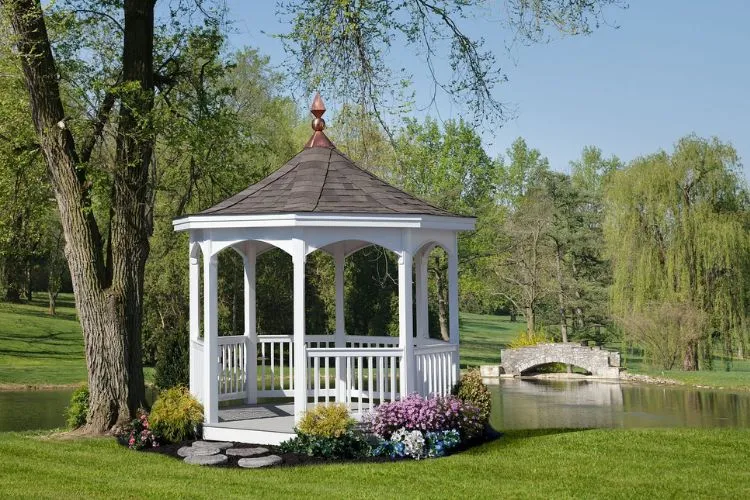Gazebos stand as a testament to the elegance and utility of traditional garden structures.
Serving as focal points in public parks, gardens, and backyards, these freestanding pavilions are designed for a variety of uses, from quiet meditation spaces to active social gathering spots.
But, do you know how many sides does a gazebo have?
Delving into the design of gazebos, especially the number of sides they have, unveils a deeper appreciation for their architecture and functionality.

Contents
- 1 Types of Gazebos
- 2 How Many Sides Does a Gazebo Have?
- 3 Design Considerations
- 4 Installation Challenges
- 5 Maintenance and Durability
- 6 Cultural Significance
- 7 Frequently Asked Questions (FAQs)
- 7.1 What is the most common number of sides for a gazebo?
- 7.2 How does the number of sides affect the cost and complexity of building a gazebo?
- 7.3 Are there any structural advantages to having more or fewer sides on a gazebo?
- 7.4 Can a gazebo have any number of sides, or is there a limit?
- 7.5 How does the number of sides on a gazeobe affect its overall stability?
Types of Gazebos
Traditional Gazebos
The image of a traditional gazebo typically conjures thoughts of an octagonal structure, with eight sides forming a perfect balance between size and accessibility.
This design is not only aesthetically pleasing but also practical, providing ample space for a group of people while maintaining a cozy atmosphere.
The octagonal gazebo fits well in symmetrical garden layouts where the gazebo acts as a harmonious centerpiece.
Modern Variations
As architectural tastes and technologies have evolved, so too have the designs of gazebos.
Among modern gazebos, hexagonal (six-sided) structures are popular for those seeking a slightly smaller footprint, while dodecagonal (twelve-sided) structures can accommodate larger gatherings.
Non-standard, custom-shaped gazebos are also increasingly common, crafted to fit unique landscapes or specific aesthetic preferences.
These gazebos often use contemporary materials such as metal or vinyl, offering durability and style.
Rectangular and Square Gazebos
With a shift towards modern and minimalist design, four-sided gazebos have gained popularity.
These structures, either square or rectangular, integrate seamlessly with more contemporary homes and landscapes.
They offer a straightforward design that can be easier to construct than their multi-sided counterparts.
They work particularly well in formal garden settings where their clean lines enhance the structured feel of the space.
Pavilion Style
The pavilion-style gazebo, often with open sides or minimal sides, serves a different purpose.
Mainly rectangular, these are used to cover large open areas like picnic spots or outdoor performance stages.
They maximize views and enhance airflow, making them ideal for enjoying natural settings without obstruction.
How Many Sides Does a Gazebo Have?
The design of a gazebo is influenced by several factors, including the size of the space available, the architectural style of nearby structures, and the intended use of the gazebo.
Additionally, personal taste and cultural influences play significant roles in deciding the number of sides a gazebo might have.
It is important to note that more sides typically increase both the complexity of the design and construction process.
Design Considerations

Symmetry and Spatial Dynamics
The shape of a gazebo significantly affects the layout of a garden. A symmetrical gazebo can bring a sense of balance and tranquility to a space, making it a calming presence in a carefully curated garden.
This balance is crucial for achieving a harmonious interaction between the natural and built elements in a landscape.
Roofing and Material Complications
Addressing the roofing needs of gazebos, particularly those with many sides, presents unique challenges.
The complexity increases with the number of sides, not just in terms of design, but also regarding the practical aspects of construction and material selection.
The choice of materials can affect everything from aesthetics to durability, influencing the gazebo’s overall integration with its environment.
Installation Challenges
Construction Complexity
Building a gazebo becomes more complex as the number of sides increases. Each additional side requires more precise measurements and cutting of materials, demanding higher levels of craftsmanship.
This complexity can often extend the time needed to complete the project.
Cost Implications
The cost of building a gazebo generally rises with the complexity of its design. More sides mean more materials, more labor, and often, a higher overall price tag.
This cost factor is an important consideration when planning a gazebo, particularly for those working within a budget.
Maintenance and Durability
Maintaining a gazebo involves routine care tailored to its material. Wooden gazebos, cherished for their natural beauty, demand regular staining or sealing to fend off rot, insects, and weather damage.
This might include a biennial treatment with a quality wood preservative. Metal gazebos, often made from aluminum or steel, are durable but require occasional rust-proof paint applications, especially in areas where scratches expose the metal.
Vinyl gazebos, known for their low maintenance, simply need periodic cleaning with soap and water to maintain their appearance.
Regardless of the material, inspecting your gazebo annually for structural integrity, signs of wear, and necessary repairs is crucial to extending its life and ensuring safety.
Cultural Significance

Gazebos have held a beloved place in many cultures, symbolizing leisure, community, and the human connection with nature.
Historically, they emerged in ancient civilizations as spaces for contemplation and social gatherings.
In Western societies, they became centerpieces in Victorian gardens, embodying romanticism and social status.
Meanwhile, in Eastern cultures, gazebos served as spiritual and meditative retreats, reflecting a harmony between architectural ingenuity and the natural world.
Across the globe, these structures have facilitated communal bonds, hosted ceremonies, and offered solace, showcasing their enduring cultural significance and versatility.
Frequently Asked Questions (FAQs)
What is the most common number of sides for a gazebo?
The octagonal (eight-sided) gazebo is traditionally the most common and recognized form, offering a balanced design suitable for various uses.
How does the number of sides affect the cost and complexity of building a gazebo?
Generally, more sides increase both the complexity and cost of construction because they require more materials, labor, and design precision.
Are there any structural advantages to having more or fewer sides on a gazebo?
More sides can make a gazebo more stable against certain stresses, such as wind, but they also make the structure more complex and potentially costly to build.
Can a gazebo have any number of sides, or is there a limit?
Technically, a gazebo can be designed with any number of sides, limited only by practical and aesthetic considerations.
How does the number of sides on a gazeobe affect its overall stability?
Structure stability often improves with additional sides, but this also depends on material choice and construction quality.
Conclusion:
Choosing the right gazebo involves considering both aesthetic desires and functional requirements.
Whether opting for a traditional octagonal gazebo or a minimalist four-sided structure, the decision should align with the intended use and the overall design of the surrounding space.
Understanding the various aspects of gazebo design can lead to a better appreciation of these charming structures, whether planning to build one or simply enjoying their beauty in public spaces.

Sergio Gomes, a passionate advocate for outdoor living and the male voice behind Shades Authority. With years of experience, Sergio is your trusted source for expert insights on gazebos, pavilions, cabanas, pergolas, and all things outdoor shade solutions. Join him on a journey to transform your outdoor spaces into stunning, functional retreats
